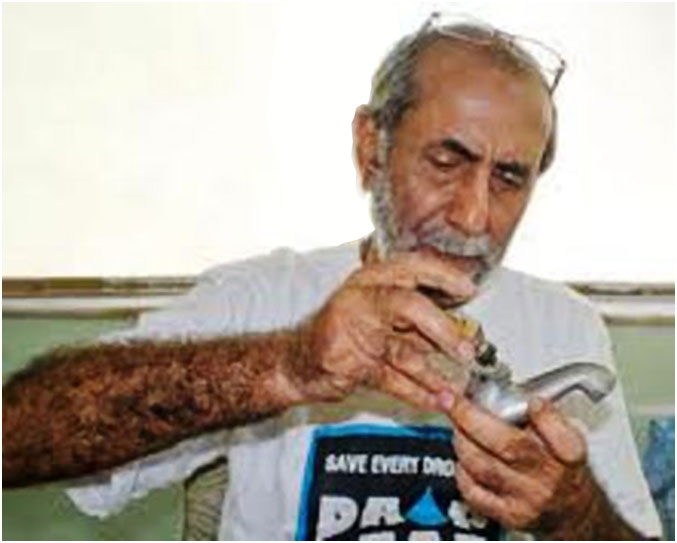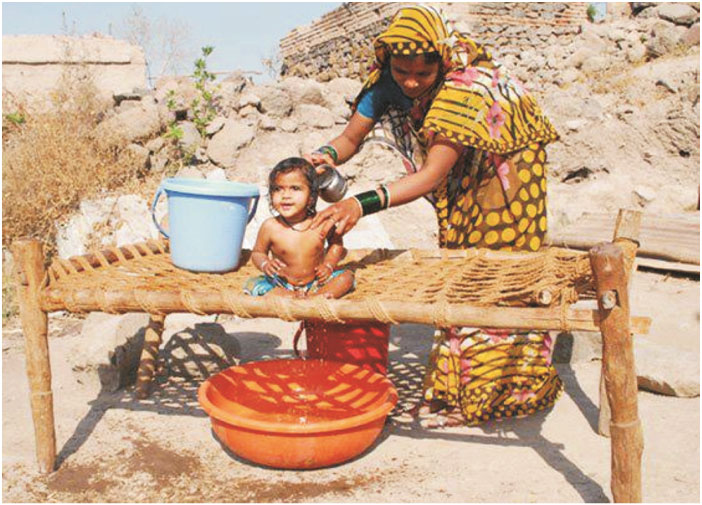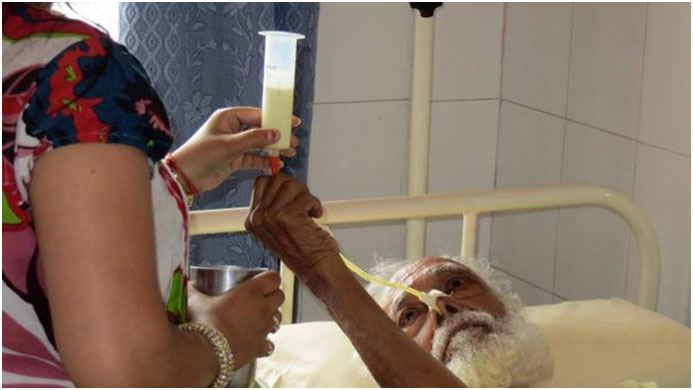If I Can You Can
Asks Gulshan Grover
How can you be water wise?
It’s easier than you think. Simple actions can have big impacts.
Healthy teeth, healthy rivers
Remember to turn off the tap while brushing your teeth – a running tap wastes over 6 litres per minute. If the entire adult population of England and Wales remembered to do this, we could save 180 mega litres a day – enough to supply nearly 500,000 homes.
Drop a Hippo in your cistern
About a quarter of all the clean, drinkable water we use in our homes is flushed down a toilet. If you’re in the market for a new loo, consider buying a water efficient toilet or one with a dual flush. If your loo is still as good as new, put a hippo or other displacement device into the cistern to save some water. Give your water company a ring; they can give you one of these devices for free.
Stop those drips
A dripping tap wastes at least 5,500 litres of water a year: that’s enough water wasted to fill a paddling pool every week for the whole summer. Mending your dripping tap washer could save you over £18 a year.
Consider installing a water efficient tap or a tap aerator – aerators in particular are cheap and simple quick fixes that you can do yourself.
Fill up those dishwashers
According to a University of Bonn study, you’re likely using more water (and energy) washing up by hand than using a modern efficient dishwasher. Even if you’re using a washing-up bowl. But make sure you fill the dishwasher or you’ll be wasting even more than if you were to wash up by hand. Become familiar with your dishwasher’s cycle options. Many settings provide the same cleaning power as a normal cycle, but with less water and energy. Check your user manual for the water consumption of other settings; if this is not provided, contact the manufacturer. Most modern dishwashers are so effective that you don’t even have to pre-rinse!
Bathers beware
A bath typically uses around 80 litres, while a short shower can use as little as a third of that amount. But beware since many power-showers may actually use more than a bath. You can minimise your water use by reusing your bathwater to water your houseplants or garden.
Short, sharp, showers save water
By using a shower timer you can increase your awareness of the amount of time you spend in the shower. Try taking shorter showers to reduce the amount of water you use.
Wishy-washy machines
Before starting your washing machine, wait for a full load – a full load uses less water than two half loads; so, you’ll be able to save money on energy and water. Familiarise yourself with your washing machine’s cycle options. Some settings provide the same cleaning power as a normal cycle, but with less water and energy. Check your user manual for water consumption information about the various cycles on your model, or contact the manufacturer.
Frigid water
Fill a jug with tap water and leave it to cool in your fridge. This way you don’t have to run the tap for ages just to get a cold drink.
Pipe preparedness
Fix leaky taps. They waste awful amounts of water! Make sure you check taps regularly and replace worn washers as soon as possible. Also, make sure to check kitchen pipes and the dishwasher hose for any leaks. Check out where your main stop valve is and make sure that you can turn it on and off. If ever a pipe bursts, you’ll know how to cut off the flow.
Sparkling asparagus
By washing your fruits and veg in a bowl rather than under a running tap, you could cut down on water waste effortlessly. And as an added bonus, you can use the leftover water to feed your houseplants.
Rubbish for rubbish bins
Try to avoid flushing away cotton balls, make-up tissues, and those pesky spiders-throwing them in the bin will cut down on the amount of water that is wasted by every flush.
Water wisdom
Effective water efficiency initiatives
Our guide to effective retrofitting projects
So simple, So effective
A call for the Ganga
Professor G.D. Agrawal at Doon Hospital in Dehradun. Photo: Vikrant Sharma A call for the Ganga
ANJANA RAJAN
Noted activist for the preservation of the Ganga, Swami Gyan Swaroop Sanand, formerly known as scientist G.D. Agrawal, tells us why India’s national river is different from all others…
He combines the clarity of a good teacher with the disdain of the activist who has given his life to a cause but not seen enough action in return. But this article cannot be about Swami Gyan Swaroop Sanand — as Ganga activist Professor G.D. Agrawal has been known since he took sanyas over two years ago. The man who has been fasting, abstaining from all food since June 13, having also given up water since September 21, says his health is his least concern. He doesn’t want to be questioned or lauded regarding his fast. “Don’t come between me and my mother,” is his refrain.
Activists for the environment allege that despite the setting up of the National Ganga River Basin Authority the damage to the river has not stopped. They call for an immediate halt to all construction on the dams on the river, and for allowing its unimpeded ecological flow. Their point is that they are not anti-development as alternative models for limited hydro-electricity generation exist.
To say that the Swami doesn’t want to meet journalists seems an understatement. There is no patience either, for the ordinary people who may not have read the scientific, social and ecological arguments against or for the hydropower projects that involve building big dams on the Ganga, which was declared a ‘National River’ by the Government of India in 2008. So for India’s variously described ‘masses’, the ascetic scientist wishes to offer no guidelines except his own fiery example. He even says the people who died in the recent Uttarakhand flash flood disaster “deserved to suffer death,” because they treat pilgrimage centres as picnic spots and don’t even think about the damage caused to the environment and to Gangaji in particular by rampant ‘spiritual’ tourism. He is not here to teach just anyone, he says, adding bluntly that a teacher chooses his students with care. But when he does begin to explain the qualities of Gangajal the teacher in him surfaces.
Reproduced below are excerpts from the statements made by the activist — three months and 16 days after beginning his fast — in a stentorian voice, while sitting upright on his bed in Doon Hospital, where the authorities have prevailed upon him to be admitted and where he is being nasally given certain liquids and his condition monitored.
On the Ganga
Gangaji is not a small physical entity. Right now there are five states through which it flows. And it has been declared a rashtriya river. We thought at that time this would mean rashtra nadi, a symbol (pehchaan) of India. We thought just as you can’t kill a peacock, India’s national bird, though you can kill a chicken, you might build a dam on the Chambal or the Betwa rivers, but you would not be able to build one on Gangaji. And when they instituted the authority they called it the National Ganga River Basin Authority. The adjective ‘national’ does not apply to the river but to the authority and it was assumed that since Gangaji is a national river and tied to the beliefs of Indians, it should be protected and this can be done through a central authority.
On the uniqueness of the Ganga which legend says was brought to earth by the efforts of Bhageerath
There is no other river in the world that has come through the effort of a human being. Gangaji is thedharohar (legacy) of our purvajas (ancestors). Its importance is not related merely to water. And if you speak merely of pollution, then would you use so-called ‘mineral water’ [regarded clean water] in place of Gangajal? So what is special about Gangajal? Bhagheerath did penance for its descent not for drinking or bathing purposes but for riddance of rogam, shokam, taapam, paapam [quoting from Adi Sankaracharya’s Ganga Stotram: Rogam, shokam, taapam, paapam/hara me Bhagawati kumati kalapam]. Rog — physical illness; shok – mental illness; and then taapam, paapam — even spiritual illness.
Scientifically recognised special qualities
The common man knows only that Gangajal does not deteriorate. Supposing you take water that has gone through reverse osmosis, given ultraviolet treatment, etc., if you keep it for two or more years, it will go bad, but Gangajal won’t. It has bactericidal properties. The 2011 report of NEERI [National Environmental Engineering Research Institute] has a lot of data, and to me that report establishes that Gangajal has these properties.
When you keep (a container of) Gangajal there is some very fine silt that settles. And if any bacteria enters the water, the silt releases copper and chromium. Copper is bactericidal and fungicidal, and chromium is very toxic for small organisms. That property is not in the water. Secondly they found Gangajal has radioactivity that is at least one-and-a-half times that of any river in the world. And that radioactivity is of the type not harmful for human health, but beneficial. Many disease causing organisms [rog jeevanu] are treated using radioactive therapy. Now this radioactive property must come from the rocks of that area.
If you build a baandh (dam), the flow is killed, velocity decreases, the rocks will not dissolve, and this property will not come into Gangajal. And if it does, then when the water is held behind the barrage, the silt settles. NEERI’s report says that 90 per cent of the fine silt is removed in the Tehri Dam. So these properties are not found below Tehri Dam, but they said this is not cause for concern because maybe — they didn’t test this — the water joining the Bhagirathi through a tributary below the dam may also have these qualities. They did test the waters of Alaknanda and found just about the same properties there. They did not test Mandakini either.
I believe the water of the three dharaein — Bhagirathi, Alaknanda and Mandakini — is exactly the same. That is why Gangaji is also known as Tripatha. [He quotes the legend that says when Shiva shook his locks, releasing Ganga, one stream (that became Alaknanda) went to pay obeisance to Vishnu in the form of Badrinath, one to Shiva at Kedarnath, and the one that fell into the kamandal of Brahma, who was standing on Gangotri, flowed out as Bhagirathi.] The three meet at Devaprayag. So I say there should be no structure built on these three rivers that affects the properties of Gangajal. Until it is proven that it will cause no damage, there is a precautionary principle from the Supreme Court for the environment that while there is doubt of damaging effects, such work should not take place, even if it takes 10 years, a hundred years [to verify]. And as for Bhagirathi’s waters, there is data stating that Tehri Dam, Maneri Dam, are causing damage.
Bacteriophagal properties
NEERI says Bhagirathi and Alaknanda have unique bacteriophages. A phage or virus is a kind of macromolecule. It cannot replicate itself in nature. It has to penetrate the body of a suitable host and use its mechanism to replicate. Now they found the properties of the bacteriophage, but it could be that macromolecule has come from the Himalayan vegetation. Even if we call it a strange form of life, it has somehow been generated in the Himalayan region. And if you send this form of life into a tunnel, where there is neither sunlight, nor air, nor soil — the tunnels are concrete lined — then will life survive?
Indian philosophical science versus modern science
There is such a stark difference between Indian philosophy and way of thinking and the modern educated so-called scientists’ way of thinking. It is very difficult for me to bridge this gap. And I would say I am a sanyasi now, not a scientist. I don’t want to talk in scientific terms. Crudely everybody would agree any living being is not just a physical body which you can define by modern science, whether biology or physics or chemistry or any of its branches. But life is so far not understood by our science at all, and when they say that they are trying, well they are trying but they don’t understand it. tapasyatapas sthalitapasya ann-shan
After all, all the energy that we have on earth came from the sun and it came in the form of waves or vibrations. So there are vibrations which science has no tools to measure so far. But that doesn’t mean they don’t exist.
Energy is transmitted even by dhyan, and pranic energy can be transmitted totally unknown to science. That way I would say, the specialty with some of our teerth sthaans is not something our science would be able to verify. And the special qualities of Gangaji or Gangajal is something I cannot convince any scientist about and so we should not keep on talking only in terms of modern, and think we are very educated or we know a lot about it. That is why I am totally not worried about health. Health has no meaning at all.





